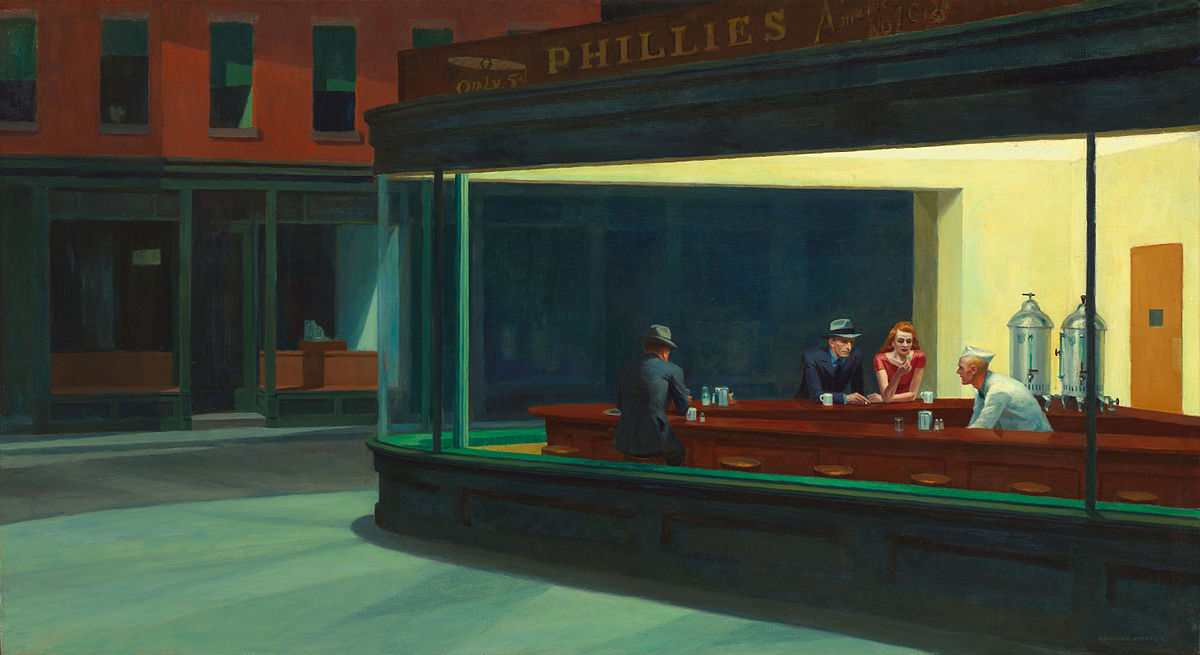 Edward Hopper’s famous painting displays a scene at a late night diner, depicting life in the city as an alienating experience despite being in the constant company of others
Edward Hopper’s famous painting displays a scene at a late night diner, depicting life in the city as an alienating experience despite being in the constant company of others
When Edward Hopper’s painting Nighthawks reached the public eye in 1942, many art critics observed two common themes: isolation and apathy. The painting, on display at the Art Institute of Chicago, is one of the best examples of Hopper’s fascination with American realism. To this day, it remains one of the most well-known paintings of the 20th century.
The painting features a small diner, lit up by abrasive fluorescent lights that spill out onto the dark and desolate streets of New York. Inside the diner are a young waiter, a man and a woman who may (or may not) be a couple, and a mysterious man who faces away from the viewers. The scene, at first glance, resembles something a late night passerby might observe in the latest hours of the night. But when we start to look a bit closer, the scene is unsettling.
While Hopper admitted that isolation wasn’t a key theme he had in mind when he created this painting, he explained that “unconsciously, probably, I was painting the loneliness of a large city.” In 1942, many were grappling with the devastating effects that WW2 was producing. Some have speculated that a newspaper rests beside the faceless man, one that may have announced ample amounts of tragic news taking place during the time. This would also explain why the diner’s occupants appear so glum.
Hopper, perhaps unknowingly, managed to do a spectacular job of capturing the feeling of urban ennui and loneliness with Nighthawks. Through the diner’s large window, we are granted a glimpse into a world where interactions appear strained and the subjects are more preoccupied with their thoughts or worries than they are with one another. They share the same space, but they appear worlds apart.
Life in the city has a way of both uniting and alienating people, especially in the darkest hours of the night. The man and woman who sit together in this painting are a prime example of this: despite sitting very close to one another, their body language emits a palpable distance. They both appear reluctant to talk to one another or meet each other’s gaze. The woman’s attention is focused on something green that she holds in her hand, while the man stares straight ahead, looking bored. Have the two been in a fight? Have they both received some bad news? Is one of them thinking of ending the relationship? Are they even in a relationship? For years, questions like these have plagued Hopper’s fans.
Another key feature of the painting lies in the exterior of the diner. The dark streets are desolate, and without the diner’s fluorescent lights, the exterior would be completely dark. Across the street stands a building, with the bottom floor occupied by what appears to have once been a store. The storefront has been cleared out, with only empty shelves serving as proof that a store ever existed here. Additionally, above the store, there are several apartment units. In one of the apartment windows, there is an eerie figure that is barely distinguishable from the dark. Many have argued that it could be a human or a cat, though on closer inspection, it resembles neither. Some have concluded that it could also be the reflection of a street light.
Despite Nighthawks’ enigmatic nature, many have resonated with this painting for its accurate depiction of what life in a metropolitan setting is like, even if Hopper never meant for viewers to interpret the painting this way.
Visuals courtesy Taylor Reddam & Edward Hopper

 Edward Hopper’s famous painting displays a scene at a late night diner, depicting life in the city as an alienating experience despite being in the constant company of others
Edward Hopper’s famous painting displays a scene at a late night diner, depicting life in the city as an alienating experience despite being in the constant company of others 


